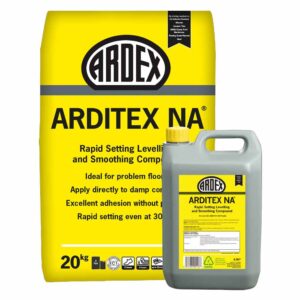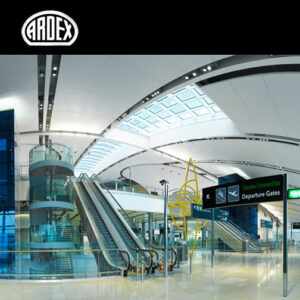Introduction & Scope
ARDEX Australia have researched and compiled the following guide on the installation of large ceramic and heavy stone tiles.
The purpose of this technical blog is to raise awareness concerning the trend towards the use of Large Format Ceramic/Porcelain and/or Heavy Stone tiles (excluding thin sheet porcelain tiles) so that appropriate tile design, selection and application can take place with all factors taken into consideration.
What is a Large Format or Heavy Stone Tile?
Due to fashion considerations, tile size has continued to grow requiring particular attention to fixing techniques that may not have been required with traditional tile sizes. Today tiles can now be defined as large format when one side is at least 400mm in length. Typically, a large format tile is 400mm x 400mm although we are now seeing the trend towards tiles in the size range 300mm x 600mm to 600mm x 1000mm tiles, and even larger sizes have become available. Rectangular shape tiles (400 x 100mm & 600 x 150mm) are also becoming increasingly popular.
Heavy stone or ceramic tiles are defined as those that exceed 32 kg/m2 in weight, although an often used guide when fixing with adhesive is a maximum weight of 4 kg per individual tile. Some of the new, extra large tiles have more in common with fascia or facade cladding elements than traditional tiles, for example so called ‘stacked stone’ tiles which are commonly 400mm – 600mm long, 100mm – 150mm wide and 15mm – 30mm thick.
What Factors Should be Considered when Fixing of a Large Format Tile?
1. Background
The first consideration is the capability of the background to support the weight of the tile. Traditional ceramic tile sizes of up to 300mm x 300mm have not normally been an issue; however the trend towards adhesive fixing of large format ceramic and stone tiles quickly raises the total bonded load to above the wall substrate manufacturer’s recommended load carrying capacity. The most contentious issue relates to the industry maximum capacity of 32 kg/m2 loading of the most common backgrounds. Whilst this figure is quoted within the Tiling Industry both in Australia and overseas, there are no current Tiling Standards that validate this limit.
The limit has been established based on the success of in-practice applications within the building industry and takes into account the broad potential risk that is associated with system failure. The question of the ability of the adhesive to support a weight of a 32 kg/m2 tile does not become an issue since the shear strength of selected ARDEX adhesives is far greater than this limit, provided that suitable adhesion is established to both the tile and the substrate. Where destructive testing has taken place, we will generally see the destruction of the tile and/or cohesive failure of the substrate before seeing failure of the adhesive bond. Another issue is the position of the substrate manufacturer with regards to application of tiles or cladding. One manufacturer of fibre-cement sheets has for example, stated that tiling over their external cladding boards is neither recommended nor warranted.
2. Tile Properties
Beyond the limitations posed by the background to sustain continuous loading under the environmental conditions imposed on it, the next consideration is that of the ability of the tile to sustain its own weight after exposure to the working environment. A case in point was an installation of sandstone tiles (dry weight of 48 kg/m²) to masonry walls, the limitations here being the ability of the masonry wall to support the weight of the sandstone and the cohesive strength of the sandstone to support itself. Porous tiles such as sandstone; will absorb water and become heavier which will result in delamination within the stone. In addition, the loading on the wall substrate may increase to be greater than the capacity of the wall to support the load.
3. Environment Conditions
The service conditions and environment that the tiling system is exposed to can affect the integrity of natural stone tiles and their backgrounds and this should influence the choice of fixing method. The example here is sandstone for external cladding which has a higher risk factor simply because the cohesive strength of sandstone is reduced when it is wet, increasing the chance of delamination within the stone when the stone itself becomes too heavy.
A similar situation applies to the backgrounds. For some types of backgrounds, such as fibre cement sheet or plasterboard, the surface strength reduces while it is wet, and consequently this reduces the maximum weight carrying capacity of the substrate. Some types of stone materials are subject to weathering. For example limestone or marbles suffer from acid rain and other fallout which dissolve or otherwise disrupt the stone tile matrix. The durability performance of the system must also be considered in terms of whether the changes from extreme heat to cold or wet, or ageing over time creates stresses between the substrate and the cladding, in the cladding or in the substrate itself. An example would be differential movements between the cladding and the substrate creating shear strains, or even fatiguing of the components or adhesive.
4. Health and Safety
The most obvious consideration, but one which needs re-emphasis is a risk assessment based on Occupational Health and Safety principles and consideration for potential catastrophic failure of the tiling system. Very weighty tiles may require particular considerations whereupon their application by the fixer can take place in a safe manner with suitable mechanical constraints engineered to ensure the safe placement of the tile. In addition, suitable engineered restraints may be required to secure the tile in place where the maximum design carrying capacity of the background or the limitations of the stone tile cohesive strength due to service or environmental conditions, is exceeded. The application of large format and/or heavy stone tiles to external facades and ever increasing tiling heights has also required due diligence with respect to establishing application limits where total reliance on the adhesive to support the tile is a requirement.
The location of tiles, in the event of catastrophic failure, becomes a critical consideration for all tile sizes. Best practice is achieved by limiting tiling heights both internally and externally to a 2.4 metre height limit, whilst evaluating the potential risk of failure to public safety. As a consequence, support for adhesive fixed tiles above 2.4 metres in height will only be considered by ARDEX on a case by case basis. Note: The practise of tiling ceilings or above open thoroughfares is not nominally recommended by ARDEX Ireland and this installation falls outside of the tiling applications discussed in BS5385. ARDEX will consider such requests on a case by case basis for adhesives such as ARDEX X77.
5. Mechanical Fixing
Where mechanical fixing becomes a requirement, appropriate design considerations are required to ensure that all components are suitable for the service conditions and working life of the tiling system. Mechanical fixings can include epoxy bonded stainless steel pins, clamp fixings, head and sill capture of stone, grooved stone edges with metal angle fixings and support or specialized proprietary systems. The use of an adhesive as a secondary support to primary mechanical fixing can result in an additional level of security that would enable the application of tiling that may not be acceptable if the adhesive was solely relied upon. Since the nature of large format ceramic and/or heavy stone tiles varies in material, nature, thickness, shape and size, the selection of a suitable fixing method resides with the architectural engineer who has designed the total system. ARDEX can work with architectural engineers to enable the correct adhesive selection. ARDEX has produced internal guidance notes to discuss some methodologies for mechanical fixing and the fibre-cement manufacturers normally have design load tables in their literature for internal tiling.
6. Site Conditions
The selection of a suitable ARDEX adhesive is best done after consideration of the exposure conditions that the adhesive will endure; the background type, and the tile type. The provision of a consistent, structurally sound and suitably prepared dry substrate free of contaminants is critical to any successful application of tiles. Tilers must be able to recognize deficiencies in site conditions that may affect the bond of the adhesive to either the background or to the tile. Allowances must be made for full cure, settlement and shrinkage of the background with additional consideration of the potential structural shrinkage of concrete structures in high rise applications. External façade tiling of some high rise applications may need to address the need for mechanical fixing of large format tiles applied lower than 3 metres above floor height, where high negative wind loadings become an issue, particularly at corners.
Another site issue is whether or not the site is in a seismic hazard, or mine subsidence area which can create dynamic loads on the cladding.
7. Conclusion
Taking all these factors into consideration, the responsibility of selecting the appropriate tiling system will reside with the project engineer to evaluate the interaction of building elements with the proposed fixing system. The engineer must take into consideration the service environment, site conditions, background loadings, tile weights, fixing methods, issues in respect of Health and Safety for the intended end use of the project, and the overall “Risk Management” assessment.
Weight Limitations of some Common backgrounds
Gypsum plaster 20kg/m²
Plasterboard and plywood 32kg/m²
Proprietary tile backing boards 60kg/m²*
Cement and sand render/concrete 64kg/m²
*Refer to manufacturer guidelines for exact weight limitations
For any further information or technical assistance please contact your nearest representative.


